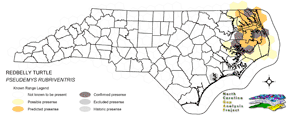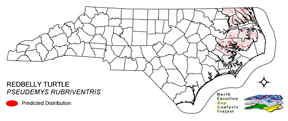
| Taxa: |
| Order: |
| Family: |
| Reptilia |
| Testudines |
| Emydidae |
| NatureServe Global Rank: |
| NatureServe State (NC) Rank: |
| G5 |
| S3 |
| Federal Status: |
| NC State Status: |
| --- |
| --- |


| Land Unit |
| US Fish & Wildlife Service |
| US Forest Service |
| US National Park Service |
| US Department of Defense |
| NC State Parks |
| NC University System |
| NC Wildlife Res. Com. |
| NC Forest Service |
| NC Div. of Coastal Mgmt. |
| Local Governments |
| Non-Governmental Org. |
| Other Public Lands |
| Private Lands |
| GAP Status 1-2 |
| All Protected Lands |
| Statewide |
| Hectares |
| 15,769.35 |
| 0.00 |
| 2,366.82 |
| 753.21 |
| 1,554.66 |
| 154.53 |
| 1,802.52 |
| 0.00 |
| 917.64 |
| 5.04 |
| 744.30 |
| 108.27 |
| 135,002.52 |
| 20,687.67 |
| 24,138.90 |
| 159,178.86 |
| Acres |
| 38,966.90 |
| 0.00 |
| 5,848.54 |
| 1,861.22 |
| 3,841.65 |
| 381.85 |
| 4,454.12 |
| 0.00 |
| 2,267.54 |
| 12.45 |
| 1,839.20 |
| 267.54 |
| 333,598.43 |
| 51,120.34 |
| 59,648.51 |
| 393,339.45 |
| % of Dist. on |
| Prot. Lands |
| 65.3 % |
| 0.0 % |
| 9.8 % |
| 3.1 % |
| 6.4 % |
| 0.6 % |
| 7.5 % |
| 0.0 % |
| 3.8 % |
| 3.1 % |
| 3.1 % |
| < 0.1 % |
| 0.3 % |
| 85.7 % |
| ----- |
| ----- |
| % of Dist. on |
| All Lands |
| 9.9 % |
| 0.0 % |
| 1.5 % |
| 0.5 % |
| 1.0 % |
| < 0.1 % |
| 1.1 % |
| 0.0 % |
| 0.6 % |
| < 0.1 % |
| 0.5 % |
| < 0.1 % |
| 84.8 % |
| 13.0 % |
| ----- |
| ----- |
|
Primarily a turtle of the coastal plain and eastern shore, this species occurs in freshwater ponds, lakes and blackwater swamps as well as in streams and rivers, brackish waters, and even salt marshes (Conant 1958, Carr 1952). They are mainly found in relatively large, deep, still or slow moving waterbodies (though also found in swifter streams) with numerous
basking sites and soft substrate for hibernation (Carr 1952). Features of preferred habitat include emergent and submerged freshwater plants, basking sites near deep water, and a soft substrate (Mitchell 1994). NATURE SERVE GLOBAL HABITAT COMMENTS: Relatively large deep bodies of water: creeks, rivers, marshes, ponds, lakes. Sometimes in brackish water. Massachusetts population in ponds only. Soft bottom and abundant aquatic vegetation preferred. Wanders on land, fall and spring. Eggs are laid in nests dug in soft soil in open areas usually within 100 yards of water (USFWS 1981). Often nests in tilled or disturbed soil (DeGraaf and Rudis 1983, Ernst and Barbour 1972). |
| Code | Name | Description | NC Natural Heritage Program Equivalent |
| 3 | Tidal Marsh | Fresh and brackish tidal marshes, including cord grass, wild rice, sawgrass and needlerush alliances. | Brackish Marsh, Interdune pond, Maritime wet grassland |
| 75 | Tidal Swamp Forest | Swamp tupelo dominated forest with or without black tupelo and/or cypress trees. Restricted to the tidal zones in the coastal plain. May have inclusions of coastal red cedar woodlands. | Tidal cypress - gum swamp |
| 121 | Maritime Pinelands | Loblolly forests and woodlands of the outer coastal plain. | Estuarine Fringe Loblolly Pine Forest |
| 17 | Maritime Forests and Hammocks | Maritime forests and woodlands dominated by live or sand laurel oak. Estuarine Fringe forests dominated by loblolly pine. | Coastal Fringe Evergreen Forest, Maritime Deciduous Forest, Maritime Deciduous Forest |
| 126 | Interdune Wooded Depression Swamp | Includes swamps dominated by sweetbay and swampbay or dogwood dominated forests. | Maritime Shrub Swamp, Maritime Swamp Forest |
| 380 | Coastal Plain Fresh Water Emergent | Emergent vegetation in fresh water seepage bogs, ponds and riverbeds of the coastal plain. Includes alliances dominated by sedges, eelgrass, as well as cane found in unforested cane-brakes. | Small Depression Pond, Sandhill Seep, Floodplain Pool, Unforested Floodplain Canebrake, Riverscour Prairies, Vernal Pools |
| 173 | Coastal Plain Riverbank Shrubs | Shrub dominated riverbanks, commonly dominated by willows and/or alders. | Sand and Mud Bar |
| 50 | Coastal Plain Mixed Bottomland Forests | Includes forests dominated by a variety of hardwood species, including sweetgum, cottonwood, red maple. | Coastal Plain Bottomland Hardwood (in part), Coastal Plain Levee Forest |
| 49 | Coastal Plain Oak Bottomland Forest | Bottomland forests dominated by deciduous oak alliances. Oaks represented can include swamp chestnut, cherrybark, willow, and/or overcup oak. Inclusions of loblolly pine temporarily flooded forests occur in patches. Hydrology is temporarily to seasonally flooded. | Coastal Plain Bottomland Hardwoods (in part) blackwater subtype, brownwater subtype |
| 158 | Coastal Plain Nonriverine Wet Flat Forests | Loblolly pine - Atlantic white-cedar - red maple - swamp tupelo saturated forests as well as forests dominated by loblolly, sweetgum, and red maple in non-riverine flats. | Non-riverine Wet Hardwood Forest |
| 41 | Peatland Atlantic White-Cedar Forest | Dense stands of Atlantic white cedar with saturated hydrology. Can include swamp tupelo, red maple, and pond pines with a moderate shrub and herb layer. | Peatland Atlantic White-Cedar Forest |
| 15 | Seepage and Streamhead Swamps | Includes extensive peat flats in the coastal plain, dominated by swamp tupelo, maples, and Atlantic white cedar alliances. In the sandhills includes streamhead pond pine and bay forests alliances. Saturated hydrology. | Bay Forest, Small Depression Pocosin, Streamhead Atlantic White Cedar Forest, Streamhead Pocosins |
| 30 | Cypress-Gum Floodplain Forests | Swamps dominated by black or swamp tupelo with or without Taxodium. Seasonally to semi-permanently flooded hydrology. | Cypress-Gum Swamps |
| 78 | Pond-Cypress - Gum Swamps, Savannas and Lakeshores | Cypress dominated swamps and lakeshores. Can include bays dominated by pond cypress or shorelines of coastal plain lakes with a narrow band of cypress. | Non-riverine Swamp Forest, Natural Lakeshores (in part) |
| 385 | Oak Bottomland Forest and Swamp Forest | The swamp chestnut oak, cherrybark oak, shumard oak and sweetgum alliance is one representative. Other alliances are dominated by water, willow, and overcup oaks. Swamp forests can be dominated by sweetgum, red maple, and black gum being dominant. Loblolly can occur in combination with sweetgum and red maple, or with tulip poplar. Includes saturated and semi- to permanently flooded forests in the mountains. | Piedmont/Mountain Bottomland Forest, Piedmont/Mountain Swamp Forest |
| 63 | Coastal Plain Mesic Hardwood Forests | Beech dominated forests with white oak and northern red oak as possible co-dominants. Dry-mesic to mesic forests on slopes and small stream bottoms in the coastal plain. | Mesic Mixed Hardwood Forest, Basic Mesic Forests |
| 138 | Coastal Plain Dry to Dry-Mesic Oak Forests | Oak dominated forests of the coastal plain. Includes white oak forests with water oak or northern red oak and hickories as co-dominants. | Dry Mesic Oak Hickory Forest, Basic Oak Hickory Forest, Dry Oak Hickory Forest |
| 87 | Pocosin Woodlands and Shrublands | Includes pond pine woodland, low pocosin and high pocosin shrub dominated areas. Canebrakes and bay forests may be present. | Pond Pine Woodlands, Peatland Canebrake, Small Depression Pocosin |
| 67 | Wet Longleaf or Slash Pine Savanna | Wet flatwoods and pine savannas, typically dominated by longleaf pines, but slash or pond pines may be the dominant pines. | Wet Pine Flatwoods |
| 97 | Mesic Longleaf Pine | Longleaf pine woodlands without a major scrub oak component. Slash or loblolly pines may be present as well. | Mesic Pine Flatwoods |
| 42 | Xeric Longleaf Pine | Sandhills including a range of longleaf pine density from predominantly wiregrass, scrub oak dominated to true longleaf pine woodland. This does not include mesic or saturated flatwood types. | Xeric Sandhill Scrub, Pine/Scrub Oak Sandhill, Coastal Fringe Sandhill |
| 46 | Xeric Oak - Pine Forests | Mixed forest dominated by yellow pines with white or northern red oaks co-dominating. | Pine Oak Heath |
| 232 | Xeric Pine-Hardwood Woodlands and Forests | Mixed forest dominated by yellow pines with drier oaks including southern red, post, and chestnut oaks. | Dry Oak Hickory Forest |
| 267 | Riverbank Shrublands | Riverside shrubs with temporarily flooded hydrologies. Found in the both the Mountains and Piedmont. Containing dominants such as smooth alder and a Carolina or black willows. | Sand and Mud Bar |
| 20 | Coniferous Regeneration | Regenerating pine stands. Predominantly loblolly pine, but slash and longleaf stands occur as well. | No equivalent |
| 21 | Coniferous Cultivated Plantation (natural / planted) | Managed pine plantations, densely planted. Most planted stands are loblolly, but slash and longleaf occur as well. | No equivalent |
| 51 | Deciduous Cultivated Plantation | Planted deciduous trees. Includes sweetgum and sycamore plantations. | No equivalent |
| 36 | Successional Deciduous Forests | Regenerating deciduous trees with a shrub stature. Commonly dominated by sweetgum, tulip poplars and maples. | No equivalent |
| 180 | Agricultural Crop Fields | Farm fields used for row crops. | No equivalent |
| 205 | Agricultural Pasture/Hay and Natural Herbaceous | Farm fields used for pasture grass or hay production, as well as old fields dominated by native and exotic grasses. | No equivalent |
| 8 | Open water | Open water without aquatic vegetation. | No equivalent |
|
Seidel, M. E. 1994. Morphometric analysis and taxonomy of cooter and red-bellied turtles in the North American genus PSEUDEMYS (Emydidae). Chelonian Conservation and Biology 1(2):117-130.
Browne, R. A., N. A. Haskell, C. R. Griffin, and J. W. Ridgeway. 1996. Genetic variation among populations of the redbelly turtle (PSEUDEMYS RUBRIVENTRIS). Copeia 1996:192-195. Carr, A. 1952. HANDBOOK OF TURTLES. CORNELL UNIV. PRESS, ITHACA. 542 PP. Graham, T. E. 1991. PSEUDEMYS RUBRIVENTRIS. Cat. Am. Amph. Rept. 510.1-510.4. Mitchell, J. C. 1994. The reptiles of Virginia. Washington, DC: Smithsonian Institution Press. Iverson, J. B., and T. E. Graham. 1990. Geographic variation in the redbelly turtle, PSEUDEMYS RUBRIVENTRIS (Reptilia:Testudines). Ann. Carnegie Mus. 59:1-13. Ernst, C. H., and R. W. Barbour. 1972. Turtles of the United States. Univ. Press of Kentucky, Lexington. x + 347 pp. U. S. Fish & Wildlife Service. 1981. Plymouth red-bellied turtle recovery plan. U.S. Dept. of the Interior. 1981. Plymouth red-bellied turtle recovery plan. U.S. Fish and Wildlife Service, Region 5, 13 pp. DeGraaf, R. M., and D. D. Rudis. 1983. Amphibians and reptiles of New England. Habitats and natural history. Univ. Massachusetts Press. vii + 83 pp. Seidel, M. E., and W. M. Palmer. 1991. Morphological variation in turtles of the genus PSEUDEMYS (Testudines:Emydidae) from central Atlantic drainages. Brimleyana 17:105-135. |
For more information please contact them at:
NC-GAP Analysis Project
Dept. of Zoology, NCSU
Campus Box 7617
Raleigh, NC 27695-7617
(919) 513-2853
www.basic.ncsu.edu/ncgap